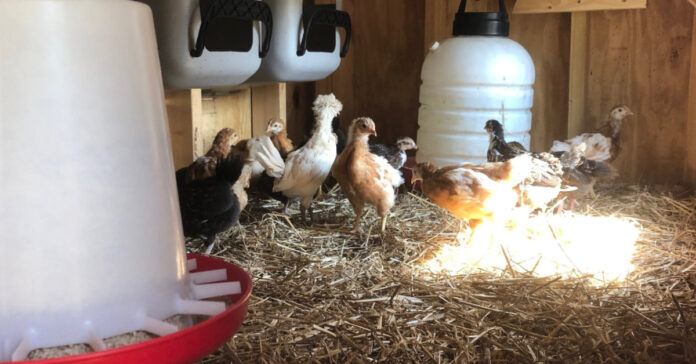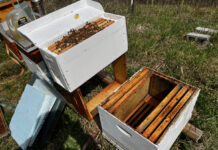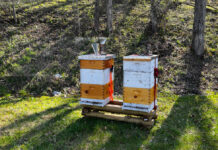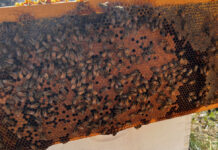We moved the chickens from their brooder into the coop yesterday. We did this by carrying the brooder (a large dog crate) out to the coop and trying to coax the chickens to move from the brooder into the coop. The change of scenery scared them, and they cowered at the back of the brooder, refusing to go into the coop.
You’d think they would want more room, but perhaps that much space was intimidating. We had to drive them from the back of the box until they ran into the coop in a panic. Once there, they quickly adapted to their new environment and immediately started scratching and searching for edibles in the straw we use as bedding.
One of the nice things about the move is that we can now give them larger food and water containers. I was filling the old food container three times per day and the waterer twice per day. The chicks found the food right away. Because it is larger, there are more feeding stations, so less crowding.
We also gave the pieces of zucchini, along with plenty of grass and clover. They like their greens.
Since I sized the coop for 16 adult birds, there is plenty of room in there for 17 immature chickens. The larger space is allowing the birds to run around. Funny thing, they have not yet used the roosts. I may have to pick one up and put it on the roost until they get the idea.
Venturing Outside
We are not letting the chickens out of their coop for a few days. We want them to become used to it and think of it as their home before we let them venture outside. That way, they are more likely to go back inside the coop as night falls.
Given how unwilling they were to leave the brooder, I think we may have a hard time getting them to leave the coop the first time. I expect they will sit inside, peer out the door but not leave.
Honey Production Moves Ahead
I did a brief hive inspection over the weekend in which I looked only in the top brood boxes, instead of breaking the boxes apart and also looking in the lower hive body as well.
The hive to which I have added a honey super (i.e. a separate hive body in which no eggs are laid and where honey is stored by the bees) is doing well and has drawn out several frames of comb. I have stopped feeding this hive so that any honey produced in it will be from nectar. We still have some flowers and trees to bloom at this altitude, so the honey flow should have at least another three or four weeks to go.
Another have is filling its second hive body and I expect I will add a new honey super to it later this week. I will need to build and paint a few new supers at this rate.
I got to stop by my friend’s house and watch them harvest honey from their flow hive. Because it was just like the video I showed a few days ago, I have little to report. Pretty quick, and far less sticky than the traditional honey harvesting process.







